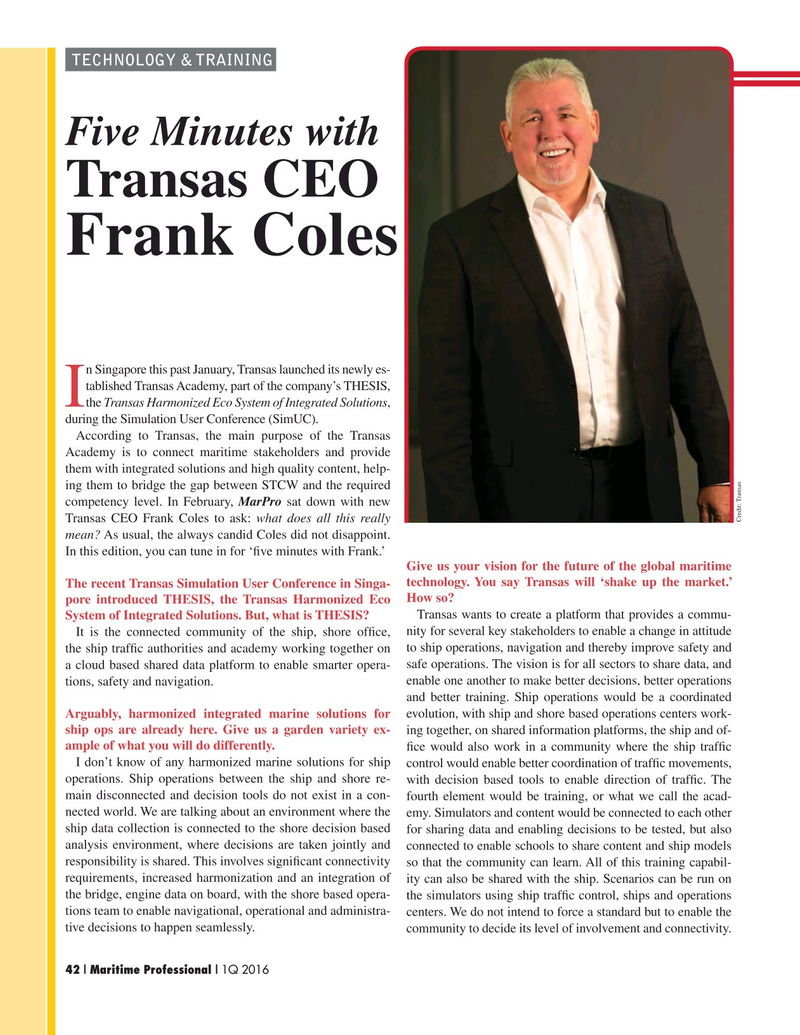
Page 42: of Maritime Logistics Professional Magazine (Q1 2016)
Maritime Training and Education
Read this page in Pdf, Flash or Html5 edition of Q1 2016 Maritime Logistics Professional Magazine
TECHNOLOGY & TRAINING
Five Minutes with
Transas CEO
Frank Coles n Singapore this past January, Transas launched its newly es- tablished Transas Academy, part of the company’s THESIS,
I the Transas Harmonized Eco System of Integrated Solutions, during the Simulation User Conference (SimUC).
According to Transas, the main purpose of the Transas
Academy is to connect maritime stakeholders and provide them with integrated solutions and high quality content, help- ing them to bridge the gap between STCW and the required competency level. In February, MarPro sat down with new
Credit: Transas
Transas CEO Frank Coles to ask: what does all this really mean? As usual, the always candid Coles did not disappoint.
In this edition, you can tune in for ‘? ve minutes with Frank.’
Give us your vision for the future of the global maritime technology. You say Transas will ‘shake up the market.’
The recent Transas Simulation User Conference in Singa- pore introduced THESIS, the Transas Harmonized Eco How so?
System of Integrated Solutions. But, what is THESIS? Transas wants to create a platform that provides a commu-
It is the connected community of the ship, shore of? ce, nity for several key stakeholders to enable a change in attitude the ship traf? c authorities and academy working together on to ship operations, navigation and thereby improve safety and a cloud based shared data platform to enable smarter opera- safe operations. The vision is for all sectors to share data, and tions, safety and navigation. enable one another to make better decisions, better operations and better training. Ship operations would be a coordinated
Arguably, harmonized integrated marine solutions for evolution, with ship and shore based operations centers work- ship ops are already here. Give us a garden variety ex- ing together, on shared information platforms, the ship and of- ample of what you will do differently. ? ce would also work in a community where the ship traf? c
I don’t know of any harmonized marine solutions for ship control would enable better coordination of traf? c movements, operations. Ship operations between the ship and shore re- with decision based tools to enable direction of traf? c. The main disconnected and decision tools do not exist in a con- fourth element would be training, or what we call the acad- nected world. We are talking about an environment where the emy. Simulators and content would be connected to each other ship data collection is connected to the shore decision based for sharing data and enabling decisions to be tested, but also analysis environment, where decisions are taken jointly and connected to enable schools to share content and ship models responsibility is shared. This involves signi? cant connectivity so that the community can learn. All of this training capabil- requirements, increased harmonization and an integration of ity can also be shared with the ship. Scenarios can be run on the bridge, engine data on board, with the shore based opera- the simulators using ship traf? c control, ships and operations tions team to enable navigational, operational and administra- centers. We do not intend to force a standard but to enable the tive decisions to happen seamlessly. community to decide its level of involvement and connectivity.
42 | Maritime Professional | 1Q 2016 34-49 Q1 MP2016.indd 42 2/29/2016 11:13:59 AM

 41
41

 43
43
